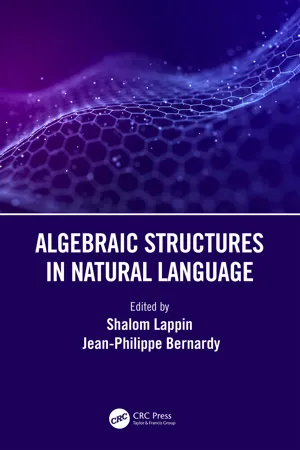
- 290 pages
- English
- ePUB (mobile friendly)
- Available on iOS & Android
Algebraic Structures in Natural Language
About this book
Algebraic Structures in Natural Language addresses a central problem in cognitive science concerning the learning procedures through which humans acquire and represent natural language. Until recently algebraic systems have dominated the study of natural language in formal and computational linguistics, AI, and the psychology of language, with linguistic knowledge seen as encoded in formal grammars, model theories, proof theories and other rule-driven devices. Recent work on deep learning has produced an increasingly powerful set of general learning mechanisms which do not apply rule-based algebraic models of representation. The success of deep learning in NLP has led some researchers to question the role of algebraic models in the study of human language acquisition and linguistic representation. Psychologists and cognitive scientists have also been exploring explanations of language evolution and language acquisition that rely on probabilistic methods, social interaction and information theory, rather than on formal models of grammar induction.
This book addresses the learning procedures through which humans acquire natural language, and the way in which they represent its properties. It brings together leading researchers from computational linguistics, psychology, behavioral science and mathematical linguistics to consider the significance of non-algebraic methods for the study of natural language. The text represents a wide spectrum of views, from the claim that algebraic systems are largely irrelevant to the contrary position that non-algebraic learning methods are engineering devices for efficiently identifying the patterns that underlying grammars and semantic models generate for natural language input. There are interesting and important perspectives that fall at intermediate points between these opposing approaches, and they may combine elements of both. It will appeal to researchers and advanced students in each of these fields, as well as to anyone who wants to learn more about the relationship between computational models and natural language.
Frequently asked questions
- Essential is ideal for learners and professionals who enjoy exploring a wide range of subjects. Access the Essential Library with 800,000+ trusted titles and best-sellers across business, personal growth, and the humanities. Includes unlimited reading time and Standard Read Aloud voice.
- Complete: Perfect for advanced learners and researchers needing full, unrestricted access. Unlock 1.4M+ books across hundreds of subjects, including academic and specialized titles. The Complete Plan also includes advanced features like Premium Read Aloud and Research Assistant.
Please note we cannot support devices running on iOS 13 and Android 7 or earlier. Learn more about using the app.
Information
Table of contents
- Cover Page
- Half-Title Page
- Title Page
- Copyright Page
- Dedication Page
- Contents
- Preface
- Contributors
- Introduction
- Chapter 1 On the Proper Role of Linguistically Oriented Deep Net Analysis in Linguistic Theorising
- Chapter 2 What Artificial Neural Networks Can Tell Us about Human Language Acquisition
- Chapter 3 Grammar through Spontaneous Order
- Chapter 4 Language is Acquired in Interaction
- Chapter 5 Why Algebraic Systems aren't Sufficient for Syntax
- Chapter 6 Learning Syntactic Structures from String Input
- Chapter 7 Analysing Discourse Knowledge in Pre-Trained LMs
- Chapter 8 Linguistically Guided Multilingual NLP
- Chapter 9 Word Embeddings are Word Story Embeddings (and That's Fine)
- Chapter 10 Algebra and Language: Reasons for (Dis)content
- Chapter 11 Unitary Recurrent Networks